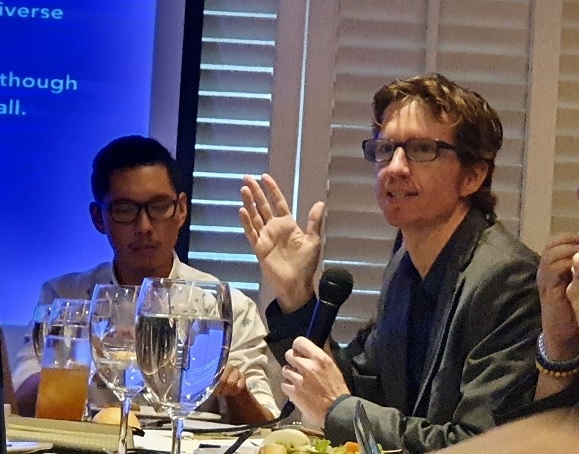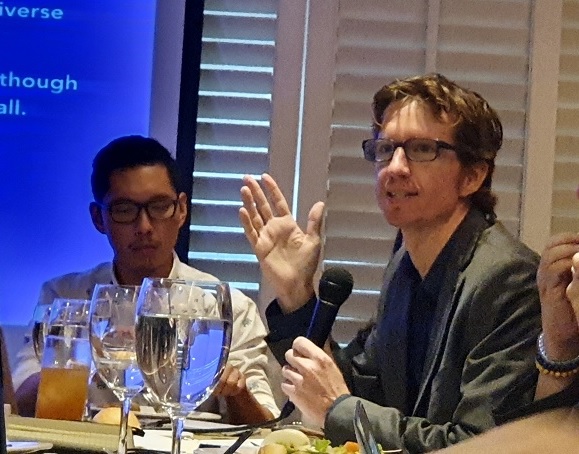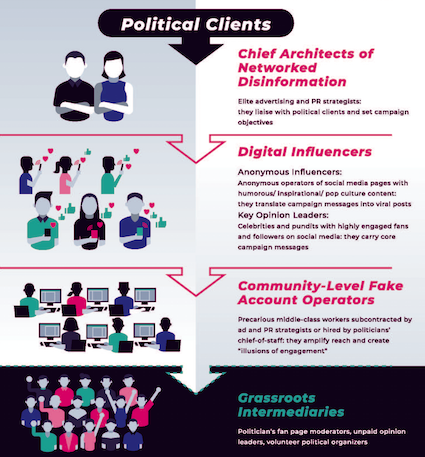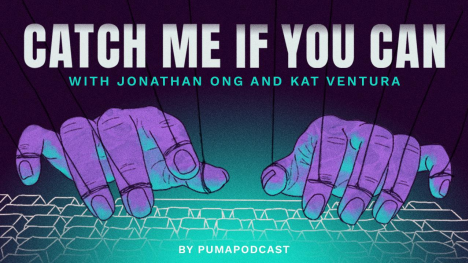
Ross Tapsell, senior lecturer at Australia National University, one of the authors of the study “Tracking Digital Disinformationin the 2019 Philippine Midterm Elections” explains their research during the launch Aug.9 at Bay Leaf Hotel in Intramuros, Manila. Beside him is his co-author Jonathan Ong. Photo by Celine Samson.
To combat new forms of disinformation and propaganda that circulated on social media during the Philippine elections in May, three academics who studied the midterm polls suggest transparency in digital campaign spending in the 2022 electoral exercise.
In a study titled “Tracking Digital Disinformationin the 2019 Philippine Midterm Elections” released Friday, Aug. 9, media experts Jonathan Ong from the University of Massachusetts Amherst, Ross Tapsell of Australia National University and Nicole Curato from the University of Canberra, recommended that the Commission on Elections (COMELEC) require candidates to “sign off” on online advertisements about them, and for the poll body to come up with more specific guidelines on campaign expenditure disclosures, specifically for online materials.
Their report, which monitored the digital disinformation that flourished from January 2019 leading up to the May 13, 2019 polls, saw the rise of underground campaigns – both positive and negative – that fly under the radar of the poll body. This, in the face of larger amounts of campaign funds being funneled into online material.
“The digital campaigners we interviewed declared that they now get a more significant chunk of the campaign war chest, with some campaigns allocating up to fifty percent of their ‘air’ budget to social media,” they said.
Comelec’s current policy for political advertisements online, however, “enables politicians to skirt responsibility to report on informal work arrangements” such as the use of Facebook ads, “influencer” collaborations and political consultancies with public relations (PR) firms, which the researchers said, usually do not have formal documentation.
At the moment, Comelec’s January resolution on campaign spending requires only candidates’ official blogs and social media pages to be registered with them, as well as blogs and social media channels that, “when taken as a whole,” its primary purpose is to endorse a candidate.
Ong, Curato and Tapsell’s study observed that campaign strategists have weaponized “micro-influencers” to target small groups and feed them political campaign materials. These influencers, however, are not necessarily accounts that fall under Comelec’s definition of official candidates’ blogs.
Micro-influencers are “online celebrities targeting smaller, niche audiences,” and have a following of 20,000 netizens or less. Their appeal is a sense of “authenticity,” organically growing their audience by giving an impression of “raw aesthetic, spontaneity and therefore relatability,” the study said.
There are many types of micro-influencer accounts. One is political parody, which can either be pro-administration like @AltPhilMedia on Twitter or anti-administration like the Superficial Gazette of the Republic of the Philippines in Facebook, both used to poke fun at politicians.
“Monetisation opportunities arise upon achieving a level of fame or notoriety, and parody accounts can get roped in for paid projects promoting corporate brands or political clients,”the study said.
The same goes for pop culture accounts like the social media pages of “Senyora,” which has built its now-large-scale following of over hundreds of thousands of netizens by channeling the snobbish personality of Mexican drama antagonist “Senyora Santibanez” through humorous posts.
Ong, in an interview after the launch, said Senyora Santibanez is an asset of a PR firm. She promotes McDonald’s, she tweets for Coca -Cola. ”When the PR firm gets political [clients], it will also tap its existing partners.”
Another new type of micro-influencer account features “thirst trap Instagrammers,” or young men on Instagram sharing “shirtless (photos), gym gains, and lifestyle selfies.”
In the last elections, some of these men, in between their usual lifestyle posts, published official campaign material of 95-year-old senatorial candidate Juan Ponce Enrile, ostensibly to appeal to “young gay men and women” on the social networking site. None of the accounts specified if it was a sponsored or paid ad.
“[T]his practice… exploits a vulnerability in existing campaign regulation of digital PR and limits on campaign spending,” said the study, which also raised questions about political campaigns and advertisements that are spread through boosted posts on Facebook.
Currently, Comelec rules only require that expenditures on official social media accounts of candidates and receipts be included in their Statement of Contributions and Expenditures (SOCE).
Facebook allows online posts to be “boosted” with a fee, for it to reach a certain demographic and specific city locations. One political operator interviewed for the study said they indeed spent a lot on boosted posts and sponsored posts “to target a very specific area… (because that is) the only way to reach [your] target.”
However, the study noted that it was unclear who spent on such posts or if there is a “money trail.”
While the researchers lauded the Comelec’s move this January to include social media expenses in its guidelines for campaign expenditures, it reiterated the need to encourage further transparency from candidates to fill in the loopholes that were exploited in the last elections.
“We encourage COMELEC to provide more detailed guidelines to politicians and revise SOCE (Statement of Contributions and Expenditures) forms to include the variety of digital campaign executions, including the mobilising of paid influencers, the maintenance of supplemental accounts, and their principles in micro-targeted advertising,” they said.
To fight disinformation and encourage accountability, the study also raised the question as to why candidates are required to sign off on contributed television, radio and print ads for them, but not those published online.
The Comelec resolution states election propaganda donated or contributed to candidates, before being printed, published, aired, or exhibited, should have a written acceptance by the candidate or party.
“The current framework… needs to be amended to oblige politicians to sign off on social media content just as they are obliged to approve TV, radio and print advertising content,” the study further said.
In fighting disinformation, the researchers find more value in encouraging a culture of openness through disclosure rather than banning or policing content.
Recently, in an effort to protect the public from “the deleterious effects of false and deceiving content online,” Senate President Vicente “Tito” Sotto III filed a bill seeking to penalize and jail those who produce and share false content online.
However, the researchers said regulation of content “often bristles against liberal principles of free speech” and grants governments the power of social media censorship, as evidenced by countries such as Malaysia, Thailand and Singapore which all have passed their versions of anti-fake news laws.
To pass the same piece of legislation in the country is “worrying,” said the researchers, especially with the Duterte administration’s “pattern” of silencing critics and creating chilling effects on mainstream news outlets through “its arbitrary deployment of legal sanctions.”
“Iyong government regulation na ayaw natin is iyong parang Sotto-style na censorship. So regulation na transparency-focused, to me, is good (The government regulation that we don’t want is something like the Sotto-style censorship. So regulation that is transparency-focused, to me, is good),” said Ong.
Read the full study here.




